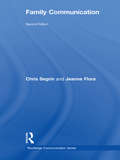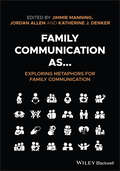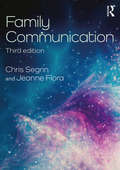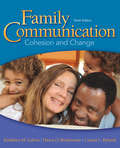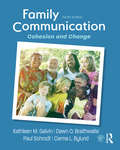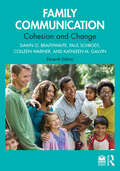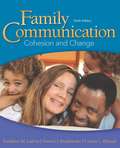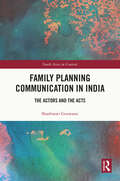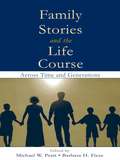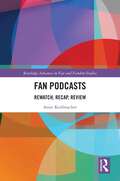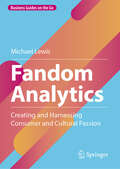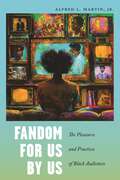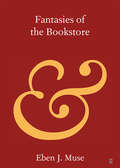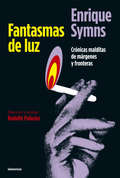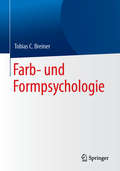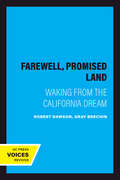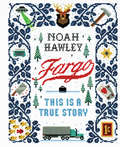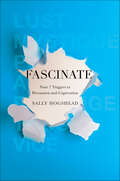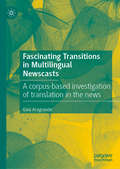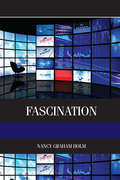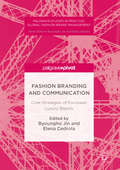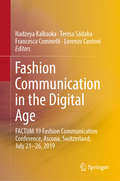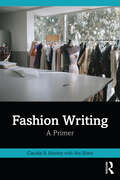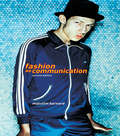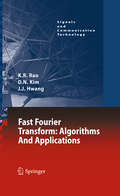- Table View
- List View
Family Communication (2nd Edition)
by Chris Segrin Jeanne Flora<p>Family Communication carefully examines state-of-the-art research and theories of family communication and family relationships. In addition to presenting cutting-edge research, it focuses on classic theories and research findings that have influenced and revolutionized the way scholars conceptualize family interaction. This text offers a thorough and up-to-date presentation of scientific research in family communication for both teachers and students of family communication as well as professionals who work with families. This second edition features: <p> <li>Chapters updated with the latest research, including over 2000 references. <li>Material on understudied family relationships, such as extended family relationships and gay and lesbian relationships <li>Recent research on understudied topics in family communication, including the influence of technology on mate selection, negotiating work and family stress, single parenting, cohabitation, elder abuse, forgiveness in marriage, and the links among communication, culture, and mental health. <li>A revised chapter on parent-child communication, taking a lifespan perspective that helps organize the large body of research in this area. <li>A new chapter devoted to extended family relationships, with special focus on grandparent-grandchild relationships, in-law relationships, and adult children and their parents. <li>An expanded review of family conflict processes, especially in relation to decision making and power. <p> <p>A companion website provides chapter outlines, exam questions, and PowerPoint slides for students and instructors. Undergraduate readers should find the information easy to understand, while advanced readers, such as graduate students and professionals, will find it a useful reference to classic and contemporary research on family communication and relationships.</p>
Family Communication as... Exploring Metaphors for Family Communication
by Jimmie Manning Jordan Allen Katherine J. DenkerAn innovative textbook that presents a novel and compelling examination of family communication studies Family Communication as… Exploring Metaphors for Family Communication presents a series of metaphors through which students explore the nuances and complexities of family interaction. With a unique approach to the foundational theories and real-world practices of family communication, this easily accessible textbook helps students develop a clear understanding of what family communication is and what it can be. Contributions by both prominent and newer scholars theorize about family communication, offer new perspectives, challenge long-held assumptions, and describe original research to provide students with an up-to-date representation of the leading thinking in the field. Each concise chapter focuses on a specific element of family life, engaging key metaphors to stimulate classroom discussion about family in contexts ranging from ritual and embodiment to estrangement and heteronormativity. Throughout the text, students examine family metaphorically—as memory, as social identity, as estrangement, as loss, as resilience, as raced, and more. Presents a metaphorical examination of creating, materializing, contextualizing, politicizing, and complicating family communication Offers an innovative alternative to standard textbooks on the subject Features a thorough introduction advocating for the use of metaphors in teaching Discusses the key topics and theoretical approaches that have defined the field Includes detailed references, additional readings, and an instructor&’s companion website Family Communication as… Exploring Metaphors for Family Communication is an excellent textbook for advanced undergraduate and graduate students in courses including family communication, family studies, interpersonal communication, relational communication, and communication theory. It is also a highly useful resource for scholars in fields such as media studies, psychology, sociology, social work, counseling, and public health.
Family Communication: Chris Segrin (Routledge Communication Series)
by Chris Segrin Jeanne FloraFamily Communication carefully examines state-of-the-art research and theories of family communication and family relationships. In addition to presenting contemporary cutting-edge research, it also includes extensive presentation and application of classic theories and findings in family science that have informed current day understandings of essential family processes. This text represents a current and comprehensive presentation of information generated by principled research conducted throughout the world for both students and teachers of family communication, as well as for professionals who work with families and seek an evidence-based understanding of functional and dysfunctional family processes. New to the third edition is an expanded coverage of understudied family relationships and diverse family forms. Each chapter is carefully updated to include important new research findings generated over the past seven years (e.g., communication in families coping with military deployment, adoption, and same sex or transgender parents). The text is also accompanied by a companion website that provides additional resources for students: extended case studies relevant to various topics and chapters in the book a media guide with links to videos and other media relevant to certain topics covered in the book an additional chapter for understanding different family communication research methods) For instructors, the companion website offers: an extensive bank of discussion and test questions
Family Communication: Cohesion and Change
by Dawn O. Braithwaite Kathleen M. Galvin Carma L. BylundFamily Communication: Cohesion and Change encourages students to observe family interaction patterns analytically and relate communication theories to family interactions. Using a framework of family functions, first-person narratives, and current research, Family Communication: Cohesion and Change emphasizes the diversity of today's families in terms of structure, ethnic patterns, and developmental experiences.
Family Communication: Cohesion and Change
by Dawn O. Braithwaite Kathleen M. Galvin Paul Schrodt Carma L. BylundFamily Communication: Cohesion and Change encourages students to think critically about family interaction patterns and to analyze them using a variety of communication theories. Using a framework of family functions, current research, and first-person narratives, this text emphasizes the diversity of today's families in structure, ethnic patterns, gender socialization, and developmental experiences. New for the tenth edition are expanded pedagogical features to improve learning and retention, as well as updates on current theory and research integrated throughout the chapters for timely analysis and discussion. Cases and research featured in each chapter provide examples of concepts and themes, and a companion website offers expanded resources for instructors and students. On the book's companion website, www.routledge.com/cw/galvin, intstructors will find a full suite of online resources to help build their courses and engage their students, as well as an author video introducing the new edition: Course Materials Syllabi & Suggested Calendars Course Projects & Paper Examples Essay Assignments Test/Quiz Questions and Answer Keys Case Studies in Family Communication Family Communication Film and Television Examples Family Communication in Literature Examples Chapter Outlines Detailed Outlines Discussion Questions Case Study Questions Sample Chapter Activities Chapter PowerPoint Slides
Family Communication: Cohesion and Change
by Dawn O. Braithwaite Kathleen M. Galvin Paul Schrodt Colleen WarnerNow in its eleventh edition, Family Communication: Cohesion and Change continues to provide students with a foundational, accessible, and inclusive overview of the family communication field.The eleventh edition represents the plurality of today’s families, helping students see themselves and think through how the up-to-date research and theory apply to their lives. It features a more concise narrative with streamlined key concepts that are more straightforward and engaging for students. Now presented in three sections, Communication and Family Lenses, Communication and Family Cohesion, and Communication and Family Adaptability, this edition’s new features include learning objectives for each chapter, Family Portrait interviews with top scholars, a glossary of key definitions, and expanded Family Reflections discussion questions interspersed in the text.This book is ideal for undergraduate courses in family communication, allied subjects in communication studies, family studies, nursing, and social work programs.The accompanying Instructor and Student Resources provide free digital materials designed to test students’ knowledge and save instructor time when preparing lessons. Please visit www.routledgelearning.com/familycommunication for interactive activities, practice quizzes, and more.
Family Communication: Cohesion and Change
by Kathleen M. Galvin Dawn O. Braithwaite Carma L. BylundAddresses the role of communication in developing and maintaining functional, diverse family relationships Family Communication: Cohesion and Change encourages students to observe family interaction patterns analytically and relate communication theories to family interaction Using a framework of family functions, first-person narratives, and current research, Family Communication: Cohesion and Change emphasizes the diversity of today's families in terms of structure, ethnic patterns, and developmental experiences. MySearchLab is a part of the Galvin/Bylund/Braithwaite program. Research and writing tools, including access to academic journals, help students understand critical thinking in even greater depth. To provide students with flexibility, students can download the eText to a tablet using the free Pearson eText app. Note: this is the standalone book, if you want the book/access card order the ISBN below: 0133814998 / 9780133814996 Family Communication: Cohesion and Change plus MySearchLab with eText -- Access Card Package Package consists of: 0205239927 / 9780205239924 MySearchLab with Pearson eText -- Valuepack Access Card 0205945236 / 9780205945238 Family Communication: Cohesion and Change
Family Planning Communication in India: The Actors and the Acts (South Asia in Context)
by Shashwati GoswamiThis book is the first systematic study on the historiography of the family planning communication process in India. It traces the history of the development of a highly technical health communication process. It discusses how the discourse on India’s population problem was at the heart of the development dialogue which was being promoted by the British colonial administration. The book examines the role of the censuses and the Five-Year plans in the development of the discussion on the population ‘explosion’ in India. Also, it critically discusses the role of the Ford Foundation’s leadership in institutionalising the communication process in India. The book essentially argues that population control communication enabled the ideas of a homogenised nation, an 'ideal' Indian woman and an ‘ideal’ Indian family. This, in turn, led to the obliteration of cultural, ethnic, geographical and economic specificities of India as a country. The volume will be of great interest to scholars and researchers of public policy, media and communication studies, Indian politics, modern Indian history and South Asian Studies.
Family Stories and the Life Course: Across Time and Generations
by Michael W. Pratt Barbara H. FieseThis edited book draws from work that focuses on the act of telling family stories, as well as their content and structure. The process of telling family stories is linked to central aspects of development, including language acquisition, affect regulation, and family interaction patterns. This book extends across traditional developmental psychology, personality theory, and family studies. Drawing broadly on the epigenetic framework for individual development articulated by Erik Erikson, as well as on conceptions of the family life cycle, the editors bring together contemporary examples of psychological research on family stories and their implications for development and change at different points in the life course. The book is divided into sections that focus on family stories at different points in the life cycle, from early childhood and the beginnings of narrative skill, through adolescence, young adulthood, midlife, and then mature adulthood and its intergenerational meaning. During each of these periods of the life cycle, research focusing on individual development within an Eriksonian framework of ego strengths and virtues is highlighted. The dynamic role of family stories is also featured here, with work exploring the links between family process, intergenerational attachment, and storytelling. Sociocultural theories that emphasize how such development is situated in the wider cultural context are also featured in several chapters. This broad lifespan developmental focus serves to integrate the exciting diversity of this work and foster further questions and research in the emerging field of family narrative. The book is intended primarily for researchers and advanced-level students in the fields of developmental and personality psychology, as well as those in family studies and in gerontology. It may also be of interest to those in the helping professions who are concerned with family therapy and family issues, and may--due to its content and illustrative material--have appeal to a wider market of the lay public. The chapters are written in a readily accessible style and the analyses are presented in a fairly non-technical way. Because family stories are charted across the lifespan, it would be a suitable companion book to a more traditional lifespan textbook in certain courses.
Fan Podcasts: Rewatch, Recap, Review (Routledge Advances in Fan and Fandom Studies)
by Anne KorfmacherStarting from the observation of the ubiquity of fan podcasts engaging in media commentary, this book explores three fan podcast genres in which commentary manifests as a structuring form: rewatch and reread podcasts, recap podcasts, and review podcasts.The author conducts a formalist genre analysis of these podcasts, close reading nine case studies to describe how the three genres function and how different fan labour manifests in podcasting. Each case study teases out the themes, style, and formal constellations of the three podcast genres, shows how different fans activate the affordances of podcasting and commentary, and reveals the distinct generic functions of the three podcast genres.This book will be of significant interest to scholars and students in podcast studies, fan studies, cultural studies and literary studies who are interested in fan podcasts, podcast genre analysis, and ways of close reading podcasts as texts.
Fandom Analytics: Creating and Harnessing Consumer and Cultural Passion (Business Guides on the Go)
by Michael LewisThe success of modern sports, entertainment, political, and other cultural categories is driven by organizations’ ability to create and manage fandom. This book explores fandom from a marketing perspective providing a multidisciplinary framework for understanding, measuring, and growing fandom. It provides a fandom analytics framework for creating and managing fandom and identifies the macro forces (technology, demographics, etc.) that are changing fandom’s structure and societal role. The book goes beyond understanding the foundations of fandom by demonstrating how marketing tools may be employed to value and manage fandom assets. It is designed for existing and new generations of sports and entertainment professionals, as well as scholars, students, and academics interested in sports and entertainment marketing and analytics.
Fandom for Us, by Us: The Pleasures and Practices of Black Audiences (Postmillennial Pop)
by Alfred L. Jr.The convergence of the politics of representation and Black fan culturesBoldly going where few fandom scholars have gone before, Fandom for Us, by Us breaks from our focus on white fandom to center Black fandoms. Alfred L. Martin, Jr., engages these fandoms through what he calls the “four C’s”: class, clout, canon, and comfort.Class is a key component of how Black fandom is contingent on distinctions between white, nationally recognized cultural productions and multicultural and/or regional cultural productions, as demonstrated by Misty Copeland’s ascension in American Ballet Theatre. Clout refers to Black fans’ realization of their own consumer spending power as an agent for industrial change, reducing the precarity of Blackness within historically white cultural apparatuses and facilitating the production of Black blockbusters like 2018’s Black Panther. Canon entails a communal fannish practice of sharing media objects, like the 1978 film The Wiz, which lead them to take on meanings outside of their original context. Comfort describes the nostalgic and sentimental affects associated with beloved fan objects such as the television show, Golden Girls, connected to notions of Black joy and signaling moments wherein Black people can just be themselves.Through 75 in-depth interviews with Black fans, Fandom for Us, by Us argues not only for the importance of studying Black fandoms, but also demonstrates their complexities by both coupling and decoupling Black reception practices from the politics of representation. Martin highlights the nuanced ways Black fans interact with media representations, suggesting class, clout, canon, and comfort are universal to the study of all fandoms. Yet, for all the ways these fandoms are similar and reciprocal, Black fandoms are also their own set of practices, demanding their own study.
Fantasies of the Bookstore (Elements in Publishing and Book Culture)
by Eben J. MuseThis Element surveys the place of the bookstore in the creative imagination (the fantasies of the bookstore) through a study of novels in which bookstores play a prominent role in the setting or plot. Nearly 500 'bookstore novels' published since the first in 1917 have been identified. The study borrows the concept of 'meaningful locations' from the field of human geography to assess fictional bookstores as narrative events rather than static backgrounds. As a meaningful location, the bookstore creates the potential for events that can occur both within the place of the store and in the wider space within which it functions. Elements of the narrative space include its spatio-temporal location, its locale or composition, and the events which these elements generate to define the bookstore's sense of place.
Fantasmas de luz: Crónicas malditas de márgenes y fronteras
by Enrique SymnsLa noche y el lado oscuro de la vida narrados por su cronista más melancólico: Symns conoce los senderos que conducen al abismo. "Escribir es más importante que vivir, somos más lo que escribimos que lo que somos", me dijo una vez Enrique Symns. Y este libro lo demuestra. Aquí se reproducen crónicas inolvidables sobre territorios calientes: el Once mundano, el Soldati heavy, la noche después de Cromañón, los panaderos, los libreros y los buscadores de oro. Enrique mete el cuerpo y el alma en cada historia. Escucha y vive lo que le cuentan esos personajes extraviados de su universo: locos soñadores, sabios pistoleros, jóvenes con los ojos envenenados y miradas de araña, parias sin refugio, poetas malditos incurables. En tiempos en que las redacciones se volvieron grises oficinas y los periodistas cada vez salen menos a la calle a buscar historias, o pasan el día en las redes sociales, Symns nos invita a seguir soñando con el periodismo.Rodolfo Palacios «Nadie sale vivo de aquí, pero Symns tiene más vidas que un gato, y en este libro nos cuenta algunos instantes testigos de una poderosa mente, una poderosa alma.»Andrés Calamaro «Enrique fue el escritor más inmerso en un submundo pocas veces tan bien retratado como en sus relatos. Un ambiente de hampones baratos, de agonías subterráneas, de alucinaciones paranoicas y miedos totalitarios.»Indio Solari «Si Borges afirmó que todo periodista escribe para el olvido, desde ese ángulo sólo Symns sería la excepción. Porque fue y sigue yendo más allá de todo límite previsible, lo que me permite ubicarlo entre los grandes chamanes de esa nada absoluta de la que logramos huir gracias a seres como él.»Fernando Noy «En una casa tomada de Londres, en una villa en Río. Asesinos y poetas. Es lo mismo. Todos intentando decir algo y presos de la implacable cárcel del lenguaje. A por ellos y a no dejarse engañar. Nadie sabe nada. Salud, Enrique, a tu juego te han llamado. Y la próxima vuelta va por mi cuenta.»Fito Páez «Symns es un escritor; en este tiempo en que cualquier imbécil se autodenomina "artista" y los ejecutivos imprimen "creativo" en su tarjeta de negocios, Symns es un escritor. Y Symns, como todo escritor, se odia a sí mismo.»Jorge Lanata
Farb- und Formpsychologie
by Tobias C. BreinerDieses Werk ist eine umfassende und praxisrelevante Darstellung zur Farb- und Formpsychologie. Mit einer klaren Sprache und über 100 farbigen Abbildungen wird Ihnen die komplexe Thematik auf eine wissenschaftliche und anregende Art veranschaulicht.Über eine allgemeine Einführung in die Grundlagen des visuellen Systems hinaus werden Sie ebenfalls spezielles Wissen zu Assoziationen, Wirkungen und Anwendungen bestimmter Farben und Formen erwerben. Speziellen Wert legt der Autor dabei auf deren Einsatz im Game Design. Es wird zudem erstmals eine neue Farbstudie präsentiert, die zeigt, dass die Assoziationen zu Farben sich in einem in sich logischen dreidimensionalen System anordnen lassen. Die daraus gezogenen überraschenden Erkenntnisse liefern mögliche Antworten auf fundamentale Fragen der Philosophie. Das Buch ist daher nicht nur ein Muss für Wahrnehmungspsychologen und Designer, sondern eine Bereicherung für alle an dieser Thematik Interessierten.
Farewell, Promised Land: Waking from the California Dream
by Robert Dawson Gray BrechinThis title is part of UC Press's Voices Revived program, which commemorates University of California Press’s mission to seek out and cultivate the brightest minds and give them voice, reach, and impact. Drawing on a backlist dating to 1893, Voices Revived makes high-quality, peer-reviewed scholarship accessible once again using print-on-demand technology. This title was originally published in 1999.This title is part of UC Press's Voices Revived program, which commemorates University of California Press’s mission to seek out and cultivate the brightest minds and give them voice, reach, and impact. Drawing on a backlist dating to 1893, Voices Revived</DIV
Fargo: This Is a True Story
by Noah HawleyThe making of the acclaimed, award-winning TV show told exactly as it occurred.From bestselling, Edgar Award-winning author Noah Hawley (Before the Fall) comes the perfect collector's item to the hit TV show based on the film Fargo. This companion to the first three seasons of Fargo, which Hawley created and executive produced, is packed with script selections-including all three pilots-candid, behind-the-scenes photography, exclusive interviews with cast and crew, and much, much more.Learn about what makes Lorne Malvo tick in a fascinating conversation with Billy Bob Thornton. Discover Kirsten Dunst's and Jesse Plemons's favorite scenes. Find out what it was like for Ewan McGregor to play both Stussy brothers. Hear from Patrick Wilson, Carrie Coon, Mary Elizabeth Winstead, and many others as Hawley, in this gorgeous, illuminating journey, takes you behind the curtain to reveal the making of one of the best shows on television.
Fascinate: Your 7 Triggers to Persuasion and Captivation
by Sally Hogshead“Fascination . . . the most powerful of product attachments . . . this pioneering book helps us approach . . . the concept in a thoughtful . . . practical manner.” —Tom Peters, national bestselling author of In Search of ExcellenceIn an oversaturated culture defined by limited time and focus, how do we draw attention to our messages, our ideas, and our products when we only have seconds to compete?Award-winning consultant and speaker Sally Hogshead turned to a wide realm of disciplines, including neurobiology, psychology, and evolutionary anthropology. She began to see specific and interesting patterns that all centered on one element: fascination.Fascination is the most powerful way to capture an audience and influence behavior. This essential book, newly revised and updated, examines the principles behind fascination and explores how those insights can be put to use to sway:• Which brand of frozen peas you pick in the case• Which city, neighborhood, and house you choose• Which profession and company you join• Where you go on vacation• Which book you buy off the shelfStructured around the seven languages of fascination Hogshead has studied and developed—power, passion, innovation, alarm, mystique, prestige, and alert—Fascinate explores how anyone can use these triggers to make products, messages, and services more fascinating—and more successful.“A transformative work, a beautifully written book that will forever change the way you see the world.” —Seth Godin, author of Linchpin“A riveting journey through the forces of fascination—how it irresistibly shapes our ideas, opinions, and relationships—and how to wield it to your advantage.” —Alan Webber, co-found, Fast Company and author of Rules of Thumb“This slight but practical work packs a big punch.” —Publishers Weekly
Fascinating Transitions in Multilingual Newscasts: A corpus-based investigation of translation in the news
by Gaia AragrandeThis book combines methods including Critical Discourse Analysis (CDA), Corpus Linguistics and comparative analysis in order to grasp the complexities and ramifications of multilingual broadcasting journalism in different national and supranational contexts. Starting with the idea that both journalism and translation are multi-layered objects and may conceal power dynamics and struggles within society, the author uses a theoretical and methodological convergence framework to analyse examples from Italy, the UK and Europe, as well as calling for larger and more systematic studies about language transfer activities in the news. This book will be of interest to students and scholars of translation, corpus linguistics, journalism and CDA.
Fascination: Viewer Friendly TV Journalism
by Nancy Graham HolmDeveloped from the established traditions of print and radio journalism, television journalism has often failed to reach its potential to develop away from these other media. However, because of the synthesis of words, pictures, and sound, television journalism has the ability to shift from simply reporting the news to weaving stories. In Fascination, veteran television journalist Nancy Graham Holm incorporates years in the field and extensive teaching experience to produce an instructive and entertaining guide to all aspects of television journalism. With a dual focus on aesthetics and technique, this book instructs the reader on the best way to use visuals and sound, different reporting techniques, and appropriate behaviour for journalists. Each chapter benefits from real-world examples and helpful tips to guide the reader through each stage of television journalism. This book is an excellent guide for those wanting to start a career in television journalism as well as seasoned professionals wishing to gain a new perspective.
Fashion Branding and Communication
by Byoungho Jin Elena CedrolaThis second volume in the Palgrave Studies in Practice: Global Fashion Management series focuses on core strategies of branding and communication of European luxury and premium brands. Brand is a critical asset many firms strive to establish, maintain, and grow. It is more so for fashion companies when consumers purchase styles, dreams and symbolic images through a brand. The volume starts with an introductory chapter that epitomizes the essence of fashion brand management with a particular emphasis on emerging branding practices, challenges and trends in the fashion industry. The subsequent five cases demonstrate how a family workshop from a small town can grow into a global luxury or premium brand within a relatively short amount of time. Scholars and practitioners in fashion, retail, branding, and international business will learn how companies can establish a strong brand identity through innovative strategies and management.
Fashion Communication in the Digital Age: FACTUM 19 Fashion Communication Conference, Ascona, Switzerland, July 21-26, 2019
by Lorenzo Cantoni Nadzeya Kalbaska Teresa Sádaba Francesca CominelliThis book represents a major milestone in the endeavour to understand how communication is impacting on the fashion industry and on societal fashion-related practices and values in the digital age. It presents the proceedings of FACTUM 19, the first in a series of fashion communication conferences that highlights important theoretical and empirical work in the field. Beyond documenting the latest scientific insights, the book is intended to foster the sharing of methodological approaches, expand the dialogue between communications’ studies and fashion-related disciplines, help establish an international and interdisciplinary network of scholars, and offer encouragement and fresh ideas to junior researchers. It is of high value to academics and students in the fields of fashion communication, fashion marketing, visual studies in fashion, digital transformation of the fashion industry, and the cultural heritage dimension of fashion. In addition, it is a key resource for professionals seeking sound research on fashion communication and marketing.
Fashion Writing: A Primer
by Claudia B. Manley Abi SloneActing as a comprehensive primer for the field of fashion writing, this book provides an accessible entry point for readers from diverse backgrounds, giving them a clear understanding of the intricacies of fashion writing, the outlets in which it appears, and the possibilities beyond the page. Fashion Writing: A Primer lays out a framework for various types of fashion writing (runway and trend reports, service pieces, features, and more), while offering students a solid foundation of fashion history, cultural touchstones, common fashion terminology, and contemporary issues affecting the fashion industry today. Featuring interviews with current fashion journalists, such as Robin Givhan, Sarah Mower, Charlie Porter, and Amanda Winnie Kabuiku, as well as annotated bibliographies centred on the themes of each chapter, this book delivers fashion writing essentials for anyone interested in the field. Readers will come away aware of the many influences on the fashion world, helping them establish credibility as a fashion writer. Covering both print and online outlets, this is a valuable text for students with an interest in fashion communication, journalism, and fashion media, as well as early career fashion professionals looking for a complete guide to the industry.
Fashion as Communication
by Malcolm BarnardWhat kinds of things do fashion and clothing say about us? What does it mean to wear Gap or Gaultier, Milletts or Moschino? Are there any real differences between Hip-Hop style and Punk anti-styles? In this fully revised and updated edition, Malcolm Barnard introduces fashion and clothing as ways of communicating and challenging class, gender, sexual and social identities.Drawing on a range of theoretical approaches from Barthes and Baudrillard to Marxist, psychoanalytic and feminist theory, Barnard addresses the ambivalent status of fashion in contemporary culture.
Fast Fourier Transform - Algorithms and Applications
by Jae Jeong Hwang K. R. Rao Do Nyeon KimThis book presents an introduction to the principles of the fast Fourier transform. This book covers FFTs, frequency domain filtering, and applications to video and audio signal processing. As fields like communications, speech and image processing, and related areas are rapidly developing, the FFT as one of essential parts in digital signal processing has been widely used. Thus there is a pressing need from instructors and students for a book dealing with the latest FFT topics. This book provides thorough and detailed explanation of important or up-to-date FFTs. It also has adopted modern approaches like MATLAB examples and projects for better understanding of diverse FFTs.
